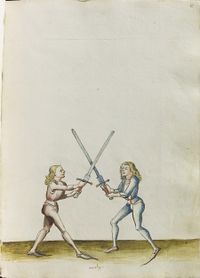|
|
You are not currently logged in. Are you accessing the unsecure (http) portal? Click here to switch to the secure portal. |
Difference between revisions of "Index:Cluny Fechtbuch (Cl. 23842)"
| (2 intermediate revisions by the same user not shown) | |||
| Pages | Pages | ||
| Line 1: | Line 1: | ||
| − | <div style="width: 60em;">Collation diagram by Michael Chidester, based on reconciling the slightly different collation formulae given by Sotheby's and Antiquariat Günther with the evidence in the scans. | + | <div style="width: 60em;">Collation diagram by [[Michael Chidester]], based on reconciling the slightly different collation formulae given by Sotheby's and Antiquariat Günther with the evidence in the scans. |
| − | Note that folio 100, currently | + | Note that folio 100, currently tipped in between 99 and 101, might have originally been the counterpart to 95 which would make its proper position between 106 and 107. |
The small numbers next to the Roman numerals are quire indicators from the lower left corner of the first folio of each quire. The first and last 11 folia are flyleaves and not assigned quire numbers (following Sotheby's and the numeration in the manuscript, but Günther numbers them and so his collation is offset by 1), though they were given folio numbers in the 19th century. | The small numbers next to the Roman numerals are quire indicators from the lower left corner of the first folio of each quire. The first and last 11 folia are flyleaves and not assigned quire numbers (following Sotheby's and the numeration in the manuscript, but Günther numbers them and so his collation is offset by 1), though they were given folio numbers in the 19th century. | ||
| − | Sotheby's assumes that the gap between Ⅴ/5 and Ⅵ/8 means that two of the unnumbered quires (Ⅹ, ⅩⅦ, ⅩⅧ) were originally located here. Even though the numbering jumps from ⅠⅩ/11 to ⅩⅠ/12, quire Ⅹ is continuous with ⅩⅠ in terms of content so it is probably in the correct position; | + | Sotheby's assumes that the gap between Ⅴ/5 and Ⅵ/8 means that two of the unnumbered quires (Ⅹ, ⅩⅦ, ⅩⅧ) were originally located here. Even though the numbering jumps from ⅠⅩ/11 to ⅩⅠ/12, quire Ⅹ is continuous with ⅩⅠ in terms of content so it is probably in the correct position; ⅩⅧ-ⅩⅨ are by a different artist, so they were probably not intended to fall into this gap either. This may therefore indicate that two quires are missing from the manuscript in between the Messer and dagger sections. |
Quires ⅩⅤ-ⅩⅦ seem disordered; since they're also much shorter than the average quire in this manuscript, it's possible there are missing folia there as well. At the least, ⅩⅦ was probably originally part of one of the two previous quires.</div> | Quires ⅩⅤ-ⅩⅦ seem disordered; since they're also much shorter than the average quire in this manuscript, it's possible there are missing folia there as well. At the least, ⅩⅦ was probably originally part of one of the two previous quires.</div> | ||
Latest revision as of 16:06, 13 January 2025
|
|

